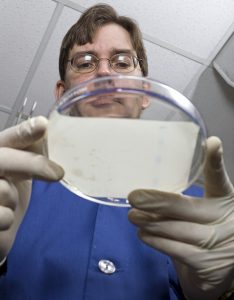
January is National Glaucoma Awareness Month
Meet Robert Nickells, PhD, a researcher in the University of Wisconsin Department of Ophthalmology and Visual Sciences. Dr. Nickells leads an active research program studying the biology of glaucoma.
Glaucoma is one of the leading causes of blindness worldwide. Although an increase in intraocular pressure is often associated with this disease, it is marked by the progressive death of retinal ganglion cells. Previous studies by Dr. Nickells’ laboratory and others have shown that ganglion cell death occurs by a mechanism that is characteristic of apoptosis – a form of programmed cell death that is regulated by a successive activation of genes from within the dying cell. Hypothetically, neuronal cell death can be blocked or prevented by agents that interrupt key biochemical pathways that are controlled by these genes. This form of treatment, termed “neuroprotection” may provide important avenues of therapy for many neurodegenerative disorders which includes glaucoma.
Dr. Nickells studies some of the earliest events that occur in retinal ganglion cells during the cell death process. “For these studies we make use of mice lacking genes critical for the cell death process,” he says. “Our current focus is on epigenetic changes that lead to silencing of normal gene expression well in advance of the committed step in the apoptotic pathway.”
Once vision is lost, no treatment can restore it. The ability to detect the disease early is a critical factor for the successful management of glaucoma. The most well-known risk factor, high intraocular pressure, may cause the damage that is glaucoma, but it is not necessarily always linked to the disease. In fact, most people with modestly high pressure will never develop glaucoma, while there is a substantial group of people who suffer from “normal tension glaucoma,” exhibiting vision loss classic to glaucoma without elevated pressures. In all types of glaucoma, lowering eye pressure is still the only available treatment to slow the progression of the disease. And although this is a relatively accepted therapy, there are still people who continue to progress toward blindness.
This seemingly variable association between pressure and susceptibility to glaucoma is why glaucoma is considered a complex genetic disease. People who are predisposed need to inherit just the right combinations of genes, which makes them sensitive to the effects of higher than normal, or even normal, eye pressure. Currently, the precise interactions between eye pressure and ganglion cell death, and the nature of the genes that predispose someone to the disease are not well understood. Researchers and clinicians know, however, that an increased understanding of these features is a critical step in developing a cure.